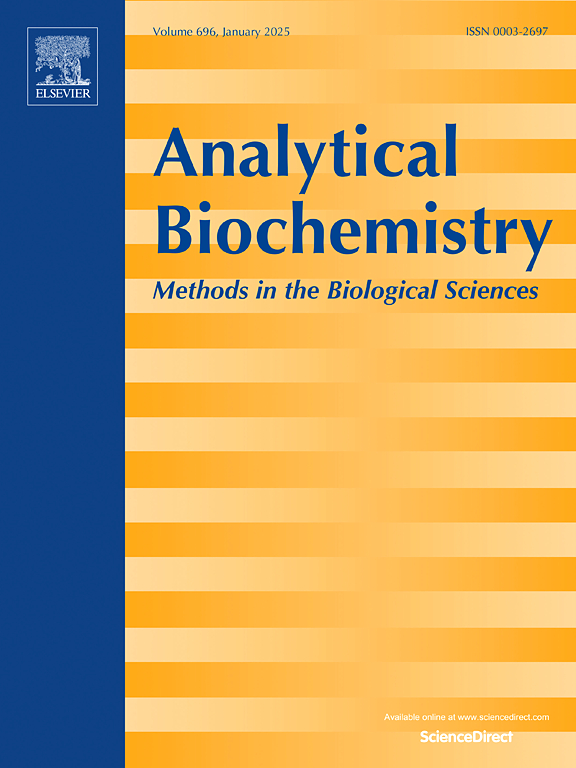Inhibition of DNA glycoxidation by mannitol and Pyridoxamine: Implications for DNA-antibody development in diabetes and diabetic retinopathy
IF 2.5
4区 生物学
Q2 BIOCHEMICAL RESEARCH METHODS
引用次数: 0
Abstract
Chronic exposure to reactive carbonyl species such as glyoxal and methylglyoxal, along with hydroxyl radicals (•OH), leads to glycative and oxidative damage, contributing to insulin resistance and diabetic complications. Pyridoxamine (PM) is known to counteract these effects, but its potential synergy with mannitol (MN), a hydroxyl radical scavenger, remains unexplored. This study investigates the combined efficacy of MN and PM in preventing glycation and oxidative damage in vitro.
Calf thymus DNA was subjected to glycation using 10 mM glyoxal, oxidation via the Fenton reaction, and sequential glycoxidation (glycation followed by oxidation). The inhibitory effects of MN, PM, and their combination were assessed using NBT reduction for early glycation, GK-ribose for AGEs, TBARS for hydroxyl radicals, and spectroscopic analyses for AGEs formation. A clinical study also examined autoantibody prevalence in diabetes and diabetic retinopathy (DR).
Results showed that glycoxidated DNA exhibited structural alterations, with MN and PM individually reducing ketoamine content. Their combination further enhanced glycation and glycoxidation inhibition. Additionally, MN-PM co-administration synergistically reduced AGEs and hydroxyl radicals. Autoantibody levels were elevated in diabetes and DR. These findings suggest PM-MN co-administration as a promising strategy to mitigate diabetic complications.

甘露醇和吡哆胺对DNA糖氧化的抑制作用:对糖尿病和糖尿病视网膜病变中DNA抗体发展的影响
长期暴露于活性羰基物质,如乙二醛和甲基乙二醛,以及羟基自由基(•OH),会导致糖化和氧化损伤,导致胰岛素抵抗和糖尿病并发症。已知吡哆沙明(PM)可以抵消这些影响,但其与甘露醇(MN)(一种羟基自由基清除剂)的潜在协同作用仍未被探索。本研究探讨了MN和PM在体外预防糖基化和氧化损伤的联合作用。小牛胸腺DNA用10毫米乙二醛糖基化,通过芬顿反应氧化,然后依次糖基化(糖基化后氧化)。通过NBT还原对早期糖基化的抑制作用、k -核糖对AGEs的抑制作用、TBARS对羟基自由基的抑制作用以及对AGEs形成的光谱分析来评估MN、PM及其组合的抑制作用。一项临床研究也检查了自身抗体在糖尿病和糖尿病视网膜病变(DR)中的患病率。结果表明,糖氧化DNA发生结构改变,MN和PM分别降低酮胺含量。它们的结合进一步增强了糖基化和糖氧化抑制。此外,MN-PM共给药可协同减少AGEs和羟基自由基。糖尿病和dr患者自身抗体水平升高,这些发现表明PM-MN联合给药是缓解糖尿病并发症的一种有希望的策略。
本文章由计算机程序翻译,如有差异,请以英文原文为准。
求助全文
约1分钟内获得全文
求助全文
来源期刊

Analytical biochemistry
生物-分析化学
CiteScore
5.70
自引率
0.00%
发文量
283
审稿时长
44 days
期刊介绍:
The journal''s title Analytical Biochemistry: Methods in the Biological Sciences declares its broad scope: methods for the basic biological sciences that include biochemistry, molecular genetics, cell biology, proteomics, immunology, bioinformatics and wherever the frontiers of research take the field.
The emphasis is on methods from the strictly analytical to the more preparative that would include novel approaches to protein purification as well as improvements in cell and organ culture. The actual techniques are equally inclusive ranging from aptamers to zymology.
The journal has been particularly active in:
-Analytical techniques for biological molecules-
Aptamer selection and utilization-
Biosensors-
Chromatography-
Cloning, sequencing and mutagenesis-
Electrochemical methods-
Electrophoresis-
Enzyme characterization methods-
Immunological approaches-
Mass spectrometry of proteins and nucleic acids-
Metabolomics-
Nano level techniques-
Optical spectroscopy in all its forms.
The journal is reluctant to include most drug and strictly clinical studies as there are more suitable publication platforms for these types of papers.
 求助内容:
求助内容: 应助结果提醒方式:
应助结果提醒方式:


